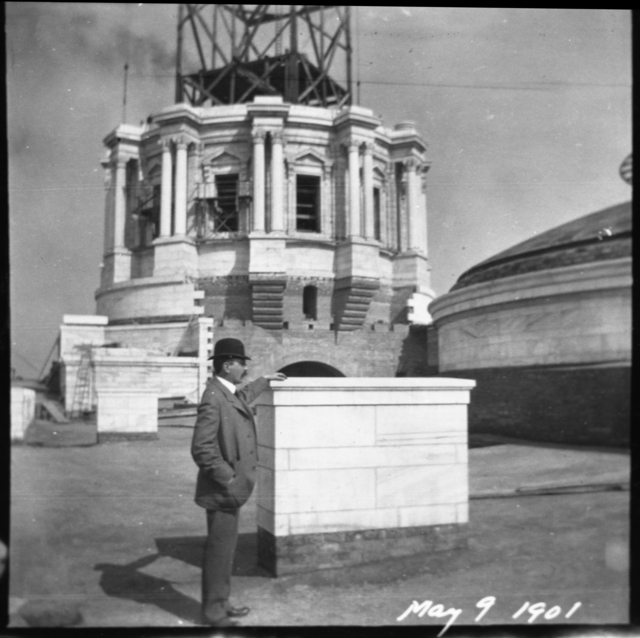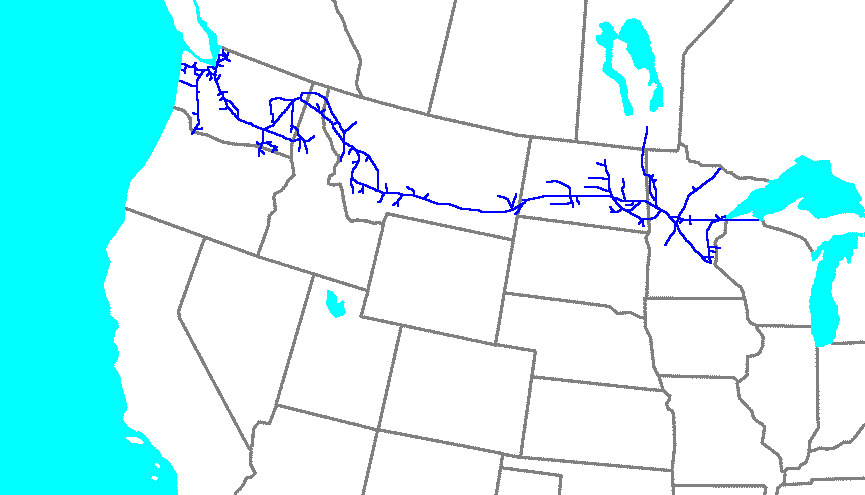|
Downtown Grand Forks
Downtown Grand Forks is the original commercial center of Grand Forks, North Dakota, United States. Located on the western bank of the Red River of the North, the downtown neighborhood is situated near the fork of the Red River and the Red Lake River. While downtown is no longer the dominant commercial area of the Greater Grand Forks community, it remains the historic center of Grand Forks. An portion was listed on the National Register of Historic Places in 2005, as Downtown Grand Forks Historic District. Today, downtown Grand Forks is home to many offices, stores, restaurants, and bars. History Early history Grand Forks was first settled in 1870. In 1872, seven pioneers staked claims to land on the Red River. The piece of land that would become downtown Grand Forks was first platted by Grand Forks' "founding father", Alexander Griggs, and his wife Etta, in 1875. This was done in anticipation of the Saint Paul and Pacific Railroad (later the St. Paul, Minneapolis and ... [...More Info...] [...Related Items...] OR: [Wikipedia] [Google] [Baidu] |
Grand Forks, North Dakota
Grand Forks is a city in and the county seat of Grand Forks County, North Dakota, United States. The city's population was 59,166 as of the 2020 United States census, 2020 census, making it the List of cities in North Dakota, third-most populous city in the state, after Fargo, North Dakota, Fargo and Bismarck, North Dakota, Bismarck. Grand Forks, along with its twin cities (geographical proximity), twin city of East Grand Forks, Minnesota, forms the center of the Grand Forks metropolitan statistical area, which is often called Greater Grand Forks or the Grand Cities. Located on the western banks of the north-flowing Red River of the North, in a flat region known as the Red River Valley, the city is prone to flooding. The 1997 Red River flood, Red River Flood of 1997 devastated the city. Originally called ''Les Grandes Fourches'' by French fur traders from Canada, who had long worked and lived in the region, steamboat captain Alexander Griggs platted a community after being forced ... [...More Info...] [...Related Items...] OR: [Wikipedia] [Google] [Baidu] |
Contributing Buildings
In the law regulating historic districts in the United States, a contributing property or contributing resource is any building, object, or structure which adds to the historical integrity or architectural qualities that make the historic district significant. Government agencies, at the state, national, and local level in the United States, have differing definitions of what constitutes a contributing property but there are common characteristics. Local laws often regulate the changes that can be made to contributing structures within designated historic districts. The first local ordinances dealing with the alteration of buildings within historic districts was enacted in Charleston, South Carolina in 1931. Properties within a historic district fall into one of two types of property: contributing and non-contributing. A contributing property, such as a 19th-century mansion, helps make a historic district historic, while a non-contributing property, such as a modern medical cl ... [...More Info...] [...Related Items...] OR: [Wikipedia] [Google] [Baidu] |
National Park Service
The National Park Service (NPS) is an List of federal agencies in the United States, agency of the Federal government of the United States, United States federal government, within the US Department of the Interior. The service manages all List of national parks of the United States, national parks; most National monument (United States), national monuments; and other natural, historical, and recreational properties, with various title designations. The United States Congress created the agency on August 25, 1916, through the National Park Service Organic Act. Its headquarters is in Washington, D.C., within the main headquarters of the Department of the Interior. The NPS employs about 20,000 people in units covering over in List of states and territories of the United States, all 50 states, the District of Columbia, and Territories of the United States, US territories. In 2019, the service had more than 279,000 volunteers. The agency is charged with preserving the ecological a ... [...More Info...] [...Related Items...] OR: [Wikipedia] [Google] [Baidu] |
Theodore B
Theodore may refer to: Places * Theodore, Australian Capital Territory, Australia * Theodore, Queensland, Australia * Theodore, Saskatchewan, Canada * Theodore, Alabama, United States * Theodore Reservoir, in Saskatchewan People * Theodore (given name), including a list of people with the name ** Theodore Roosevelt, 26th President of the United States **Grand Wizzard Theodore, American musician and DJ * Theodore (surname), including a list of people with the name Fictional characters * T-Bag (''Prison Break'') (Theodore Bagwell), in ''Prison Break'' * T-Dog (''The Walking Dead'') (Theodore Douglas), in ''The Walking Dead'' * Theodore Huxtable, in ''The Cosby Show'' * Theodore, in ''Alvin and the Chipmunks'' * Theodore Grambell, or CatNap, in video game ''Poppy Playtime'' * Theodore "The Roach" Roachmont, from Supernoobs Other uses * Theodore (horse), a British Thoroughbred racehorse * Theodore Racing, a Formula One constructor See also * Theodoros, or Theodorus * Principa ... [...More Info...] [...Related Items...] OR: [Wikipedia] [Google] [Baidu] |
Cass Gilbert
Cass Gilbert (November 24, 1859 – May 17, 1934) was an American architect. An early proponent of Early skyscrapers, skyscrapers, his works include the Woolworth Building, the United States Supreme Court building, the state capitols of Minnesota State Capitol, Minnesota, Arkansas State Capitol, Arkansas, and West Virginia State Capitol, West Virginia, the Detroit Public Library, the Saint Louis Art Museum and Saint Louis Public Library, Public Library. His public buildings in the Beaux arts (architecture), Beaux Arts style reflect the optimistic American sense that the nation was heir to Greek democracy, Roman law and Renaissance humanism. Gilbert's achievements were recognized in his lifetime; he served as president of the American Institute of Architects in 1908–09. Gilbert was a conservative who believed architecture should reflect historic traditions and the established social order. His design of the new Supreme Court building in 1935, with its classical lines and small ... [...More Info...] [...Related Items...] OR: [Wikipedia] [Google] [Baidu] |
Joseph Bell DeRemer
Joseph Bell DeRemer (1871–1944), who lived and worked in Grand Forks, North Dakota, was one of the finest architects in North Dakota. Some of the important works produced by him or his firm, which included his son Samuel Teel DeRemer, include the Oxford House (Grand Forks, North Dakota), President's House at the University of North Dakota, the Masonic Temple (Grand Forks, North Dakota), Masonic Temple, and the Art Moderne United Lutheran Church (Grand Forks, North Dakota), United Lutheran Church and North Dakota State Capitol skyscraper. Joseph DeRemer also designed houses in the Grand Forks Near Southside Historic District, most notably the Tudor Revival house presently located at 521 South Sixth Street off Reeves Drive. His significant works include a number of buildings that are listed on the U.S. National Register of Historic Places. Personal life Joseph Bell DeRemer was born in New Jersey on September 14, 1871, and studied one year at Columbia University. He married Eliz ... [...More Info...] [...Related Items...] OR: [Wikipedia] [Google] [Baidu] |
Northern Pacific Railway
The Northern Pacific Railway was an important American transcontinental railroad that operated across the northern tier of the Western United States, from Minnesota to the Pacific Northwest between 1864 and 1970. It was approved and chartered by the 38th Congress of the United States in the national / federal capital of Washington, D.C., during the last years of the American Civil War (1861-1865), and received nearly of adjacent land grants, which it used to raise additional money in Europe (especially in President Henry Villard's home country of the new German Empire), for construction funding. Construction began in 1870 and the main line opened all the way from the Great Lakes to the Pacific Ocean, just south of the United States-Canada border when Ulysses S. Grant, drove in the final "golden spike" completing the line in western Montana Territory (future State of Montana in 1889), on September 8, 1883. The railroad had about of track and served a large area, including ... [...More Info...] [...Related Items...] OR: [Wikipedia] [Google] [Baidu] |
Historic District (United States)
Historic districts in the United States are designated historic districts recognizing a group of buildings, archaeological resources, or other properties as historically or architecturally significant. Buildings, structures, objects, and sites within a historic district are normally divided into two categories, Contributing property, contributing and non-contributing. Districts vary greatly in size and composition: a historic district could comprise an entire neighborhood with hundreds of buildings, or a smaller area with just one or a few resources. Historic districts can be created by federal, state, or Local government, local governments. At the federal level, they are designated by the National Park Service and listed on the National Register of Historic Places; this is a largely honorary designation that does not restrict what property owners may do with a property. U.S. state, State-level historic districts usually do not include restrictions, though this depends on the s ... [...More Info...] [...Related Items...] OR: [Wikipedia] [Google] [Baidu] |
Alerus Financial
Alerus Financial Corporation, marketed as simply Alerus, is a chain of financial institutions headquartered in Grand Forks, North Dakota, with locations in North Dakota, Minnesota and Arizona. Alerus offers banking, mortgage, wealth management, and retirement services. History Alerus Financial's history dates back to August 29, 1879, with the formation of the Bank of Grand Forks by Mr. S. S. Titus. The bank was the second bank chartered in Dakota Territory. At the time, the bank was located in the back of a smokehouse on South Third Street in downtown Grand Forks. The bank quickly outgrew its building and moved into a new brick structure at the corner of South Third Street and Kittson Avenue. In 1881, the bank took out a federal charter and became known as Citizens National Bank. On July 1, 1890, the bank purchased another Grand Forks bank and took on the name of the other bank: First National Bank. In 1896, the newly merged First National Bank moved into the St. John's Block ... [...More Info...] [...Related Items...] OR: [Wikipedia] [Google] [Baidu] |
Metropolitan Opera House (Grand Forks, North Dakota)
The Metropolitan Opera House (or The Met) is located at 116 South Third Street in the downtown area of Grand Forks, North Dakota, USA. The building, constructed in 1890, faces the Red River of the North and sits between the BNSF Railway tracks and a parking structure. At one time, the Opera House was considered the best opera house between Minneapolis and Seattle.History - Opera Lofts.com Today, the building has been converted into an apartment building called the Opera House Lofts. History The Metropolitan Opera House was built in 1890 by the Grand Forks Opera Company on land donated by James J. Hill of the Great No ...[...More Info...] [...Related Items...] OR: [Wikipedia] [Google] [Baidu] |
Grand Forks County, North Dakota
Grand Forks County is a county in the U.S. state of North Dakota. As of the 2020 census, the population was 73,170, and was estimated to be 73,771 in 2024, making it the third-most populous county in North Dakota. The county seat and the largest city is Grand Forks. History Using territory annexed from Pembina County, the Dakota Territory legislature created Grand Forks County on January 4, 1873. Its governing structure was not established at that time, nor was the territory attached to another county for administrative and judicial purposes. The government was organized on March 2, 1875. The county's boundaries were altered in 1875, 1881, and 1883. It has retained its present boundary since 1883. Grand Forks County is included in the Greater Grand Forks (officially the Grand Forks, ND-MN Metropolitan Statistical Area). Geography According to the United States Census Bureau, the county has a total area of , of which is land and (0.22%) is water. It is the 17th largest ... [...More Info...] [...Related Items...] OR: [Wikipedia] [Google] [Baidu] |




